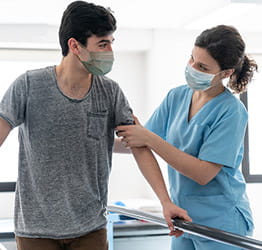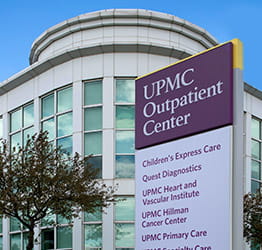At age 11, Callahan experienced his first seizure – a generalized tonic-clonic seizure, also called a grand mal seizure. This type of seizure affects both sides of the brain and involves a loss of consciousness and violent muscle contractions.
Callahan’s parents, Katie and Craig, immediately took him to the emergency department at a local hospital. There, they were connected with Dr. Rajiv Varma, a pediatric neurologist at UPMC Children’s Hospital of Pittsburgh.
“We went to Children’s, and they ran tests on Cal. We had to wait and see if he would have another seizure,” says Katie. "Three months later, he continued to have seizures. Cal started on Keppra, an anticonvulsant medication."
Dr. Varma referred Callahan to UPMC pediatric epileptologist Christina Patterson, MD, for continued medical management.
“We saw Dr. Patterson for three years, and she helped us manage and adjust Cal’s meds as needed,” says Katie. "In addition to Keppra, Cal tried Lamictal and Zonegran. Nothing was helping; the seizures just would not end."
Focal Seizures with Aura
Callahan began experiencing focal seizures as well. Focal seizures take place when the abnormal electrical brain function occurs in one or more areas of one side of the brain.
“With his focal seizures, Cal experienced auras. He said it felt constant. At that point, he was having four to five seizures a week,” says Katie.
An aura is a strange feeling typically consisting of physical, emotional, or sensory changes. Some people experience auras before the seizures occur.
“We talked with Kiersten Reznik Schaefer, PA-C, regularly to discuss Cal’s condition. She is absolutely amazing,” says Katie. “With his seizures becoming increasingly resistant to medicine, Kiersten recommended that Cal go through phase 1 testing to determine if he was a surgical candidate.”
Cal had undergone multiple routine and ambulatory electroencephalograms (EEGs), and the team hadn’t been able to capture one of his seizures. EEG testing is a non-invasive procedure that records the electrical activity of the brain to diagnose conditions like epilepsy.
Getting the Timing Right to Record Seizures
“In May 2023, we moved forward with phase 1 testing, which consisted of Cal staying in the Epilepsy Monitoring Unit (EMU) at Children’s, where he received continuous digital EEG monitoring and neuroimaging studies. During the week, he had a focal seizure, which the team recorded,” says Katie.
 Pediatric epileptologist Ruba Al-Ramadhani, MD, happened to be rounding the week that Cal was in the hospital.
Pediatric epileptologist Ruba Al-Ramadhani, MD, happened to be rounding the week that Cal was in the hospital.
“When we met Dr. Al-Ramadhani, we instantly loved her,” says Katie. "She is so warm and welcoming. You can tell she is really listening to everything you have to say.
"At the end of the week of testing, Dr. Al-Ramadhani came in and told us that they detected something and that Cal was a surgical candidate. I started crying tears of joy and relief that we may finally get answers.”
Phase 1 testing revealed that the seizures were localized to Cal’s left temporal lobe. At the end of October 2023, Cal spent one more week in the hospital undergoing testing. During this time, he had two grand mal seizures, which the team was able to capture partially.
“During Cal’s second stay, Dr. Al-Ramadhani brought in pediatric epileptologist Dr. William Welch to meet with us,” says Katie. "They shared that they were meeting with the larger pediatric epilepsy surgery team, where they planned to advocate for Cal as a surgical candidate."
A Multidisciplinary Review of the Case
Cal’s case was discussed at the multidisciplinary UPMC Children’s Pediatric Epilepsy Surgery Conference, where epilepsy cases are comprehensively reviewed by our epileptologists, epilepsy neurosurgeons, neuroradiologists, and neuropsychologists.
Before surgery, Cal would need to undergo a Wada test. This test evaluates how important each side of the brain is with respect to language and memory functions. This information helps the surgeon reduce the risk of speech and memory complications after surgery.
Alhamza Al-Bayati, MD, director of pediatric neuroendovascular surgery at UPMC Children’s, performed Cal’s Wada test in January 2024.
“The doctors first put one side of his brain to sleep. They then tested his language and memory function, and then repeated it on the other side of his brain,” says Katie. “Dr. Al-Ramadhani and Dr. Al-Bayati said that Cal did wonderfully.”
The next step for Cal was to have phase 2 stereoelectroencephalography (SEEG) testing – a surgery in which electrodes are placed directly in the brain to locate the areas where the epileptic seizures originate. This surgery was performed by Taylor Abel, MD, chief of pediatric neurosurgery and surgical director of the Pediatric Epilepsy Surgery Program at UPMC Children's.
“When they did the SEEG testing, they found a specific area deep in his brain where the seizure activity was nonstop,” says Katie. “The electrodes on the inside were able to find what the electrodes on the outside could never pick up.”
During their two-week hospital stay for Phase 2 testing, Cal and his family met with Taylor Abel, MD.
“When we met Dr. Abel, we felt totally at ease. He gave us his undivided attention,” says Katie. “He, Dr. Al-Ramadhani, and Dr. Welch would come in every day and talk with us. I never felt like I was bothering them. They made us feel like the only ones in the hospital.”
After 15 days in the hospital, the team had gathered enough information, and Cal was discharged.
“Dr. Abel worked with us to schedule Cal’s surgery and coordinate any final testing he needed. We scheduled the surgery for April 1,” says Katie. “The team explained everything about the surgery in a way we understood. Dr. Al-Ramadhani walked us through Cal’s scans and mapped out his seizures. Everything we could possibly need, the team was there.”
A Successful Neurosurgery
On April 1, 2024, Cal underwent a left temporal lobectomy at UPMC Children’s. During this procedure, the surgeon removes the part of the brain causing seizures.
After surgery, Cal recovered in the hospital for three days. Following discharge, Cal worked with a speech therapist for eight months to strengthen his language function.
Since the surgery, Cal has had no seizures and is off seizure medication completely. His entire mood has shifted.
"He used to be easily agitated and on edge, and that has gone away,” says Katie. “A week after the surgery, Cal looked at me and said, ‘It’s quiet.’ He had been living with this constant white noise in his head, and now he is finally free of it.”
Cal and his parents note that his entire life has changed for the better since surgery.
“He can drive a car, he has a job, he is enrolled in college, he can swim and exercise," says Katie. "A couple of months after the surgery, he told us that this is the first time he has been able to look forward and plan for the future."
In April 2025, Cal had his one-year follow-up with Dr. Abel and Dr. Al-Ramadhani.
“The doctors said he was all good to go and that everything looked great,” says Katie.
Off to College
Now, Cal is in his freshman year of college and enjoys going to the gym and lifting. As a lifelong swimmer, he is grateful to be cleared to swim again.
When asked about their overall experience at UPMC Children’s, Katie and Craig share their gratitude for the countless people who helped Cal.
“The doctors at Children’s are at the top of their field, but are so down-to-earth, honest, and easygoing. They were all so personable. We felt like we could talk to them forever,” says Craig.
"I never once doubted the team or their plan,” says Katie. "I knew that Dr. Abel would not steer us wrong. You truly can trust them to do what is right for your child. It was such a relief to know that Cal was in the best hands."
Callahan’s treatment and results may not be representative of all similar cases.









.png?rev=f9a364172b404c89afd23b45b93d4853&la=en&h=107&w=190&hash=1E1F9B4811EE2D75867D3EB47B0391D0)